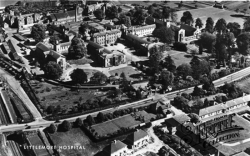Difference between revisions of "Littlemore Hospital"
(Created page with "{{infobox institution | name = Littlemore Hospital | image = littlemore.png | image_size = 250px | alt = | caption = | established = 1841 | construction_began = | construction_...") |
m (Added images) |
||
| (One intermediate revision by the same user not shown) | |||
| Line 14: | Line 14: | ||
| building_style = [[Corridor Plan Institutions|Corridor Plan]] | | building_style = [[Corridor Plan Institutions|Corridor Plan]] | ||
| architect(s) = R.N. Clark | | architect(s) = R.N. Clark | ||
| − | | location = | + | | location = Oxford |
| architecture_style = | | architecture_style = | ||
| peak_patient_population = | | peak_patient_population = | ||
| Line 35: | Line 35: | ||
The building was unsuitable for modern mental health care, and it closed in 1996, services moving to purpose built accommodation on the opposite side of the road. The original hospital building has been preserved and the site developed as housing, under the name of St. George's Park. | The building was unsuitable for modern mental health care, and it closed in 1996, services moving to purpose built accommodation on the opposite side of the road. The original hospital building has been preserved and the site developed as housing, under the name of St. George's Park. | ||
| + | ==Images== | ||
<gallery> | <gallery> | ||
File:littlemoreaerial.png | File:littlemoreaerial.png | ||
| + | File:littlemorefire.png | ||
| + | File:littlemore2.png | ||
</gallery> | </gallery> | ||
| − | [[Category: | + | [[Category:Oxfordshire]] |
[[Category:Corridor Plan Institutions]] | [[Category:Corridor Plan Institutions]] | ||
[[Category:Active Institution]] | [[Category:Active Institution]] | ||
Latest revision as of 23:12, 7 August 2014
| Littlemore Hospital | |
|---|---|
 | |
| Established | 1841 |
| Opened | 1846 |
| Closed | 1996 |
| Current Status | Preserved |
| Building Style | Corridor Plan |
| Architect(s) | R.N. Clark |
| Location | Oxford |
| Alternate Names |
|
History[edit]
In 1841 the Oxfordshire Magistrates resolved to build 'a public institution ... provided it could be done at reasonable expense'. Money was borrowed, land was purchased at Littlemore and the building was opened in 1846. Further purchases of land were made between 1849 and 1901; the final discharge of the loan was made in 1888. Six additional purchases of land were made between 1848 and 1901. Complaints that the buildings were inadequate for their purpose begin very early and continue throughout the history of the hospital. The original site was finally left in 1998, when the hospital moved to new buildings across the road.
Shortly after the opening of Littlemore the County authorities in Oxford entered into contracts with other counties and districts for patient care. Throughout the nineteenth century Oxford received payments from other authorities for looking after their patients at Littlemore, usually as an agreement for so many patients per year; patients came from the city of Oxford, the county of Berkshire and the boroughs of Reading, Abingdon and Windsor. As Littlemore was often overcrowded there were also agreements from time to time for Oxfordshire patients to be cared for elsewhere; Bethnal Green, Buckinghamshire, Dorset, Worcestershire and Kent are all mentioned.
Large numbers made it inevitable that individually tailored treatment was difficult. However, although confinement, restraint, padded cells and rough treatment were all used in the nineteenth century, the staff were forbidden to strike patients (on pain of instant dismissal) and a case of mechanical restraint in 1858 was reported at length in the annual report because it was an exception. Thomas Saxty Good, Medical Superintendent 1906-1936, introduced analytical methods.
In 1961 the Annual Report noted that changes in the treatment of patients had created domestic maintenance problems, as in earlier years much of this work was carried out by patients. Throughout the nineteenth century the men had helped with gardening and painting and the women had worked at needlework and in the laundry. Both sexes assisted with housework. By 1963 patients were working in the community; contracts for work were entered into with a Rural District Council for street cleansing, with the G.P.O. for cleaning telephones, dismantling obsolete exchanges and laying pipes and with a factory for light assembly work.
With the advent of the National Health Service Littlemore had its own Hospital Management Committee until 1968, when it was united with the Warneford under the Isis Hospital Management Committee. Both hospitals became part of Oxfordshire Area Health Authority (Teaching) in 1974, Oxfordshire Health Authority in 1982, Oxfordshire Mental Healthcare NHS Trust in 1994, Oxfordshire and Buckinghamshire Mental Health NHS Foundation Trust in 2008, and are now part of Oxford Health NHS Foundation Trust.
The building was unsuitable for modern mental health care, and it closed in 1996, services moving to purpose built accommodation on the opposite side of the road. The original hospital building has been preserved and the site developed as housing, under the name of St. George's Park.


